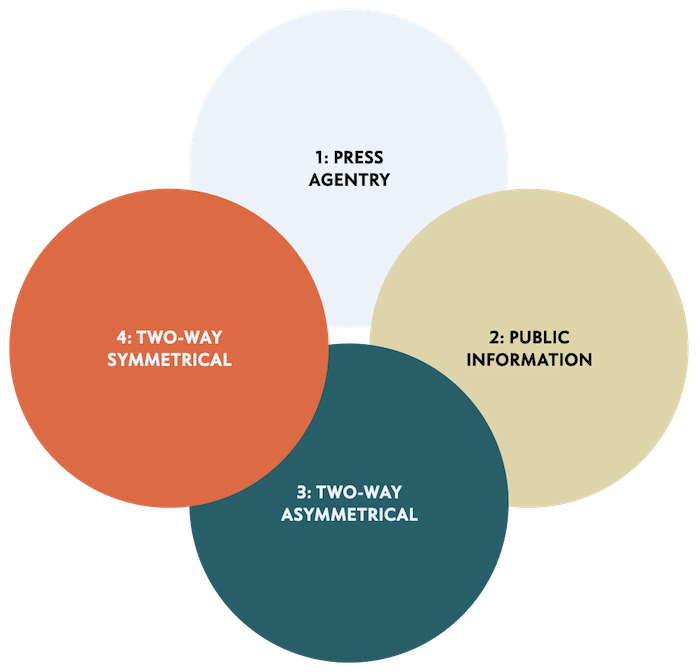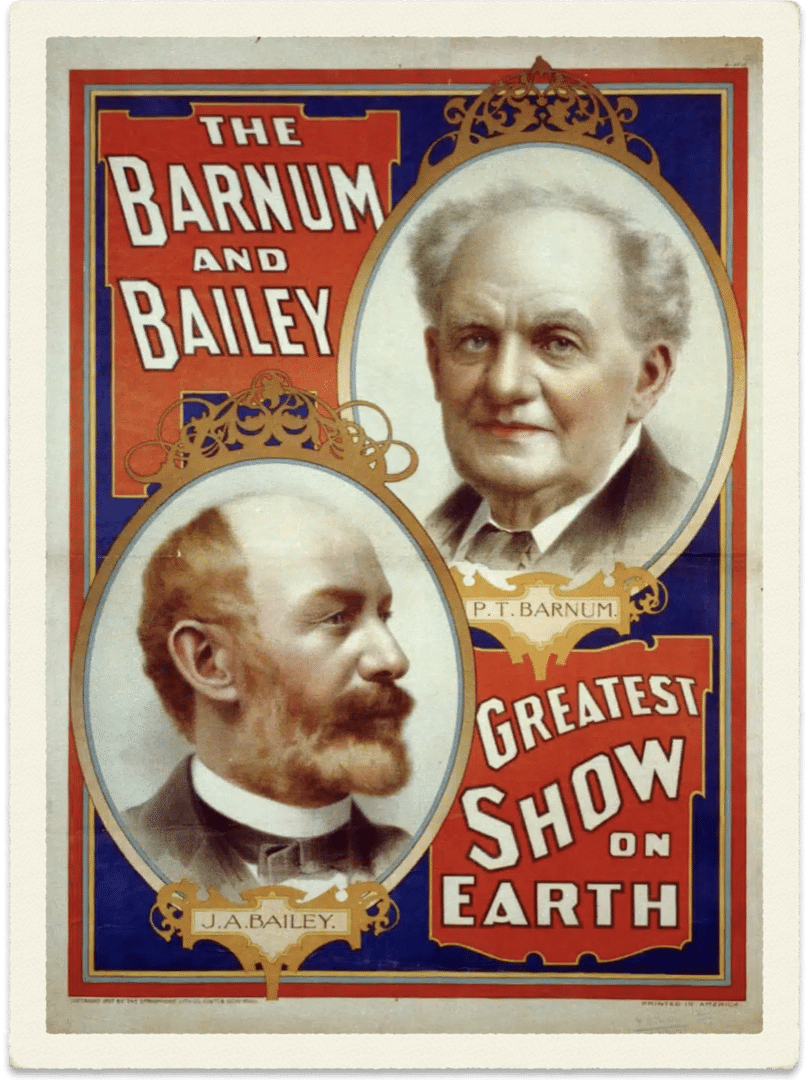There are four models of public relations.
In their seminal work, “Managing Public Relations,” James Grunig and Todd Hunt (1984) introduced four models of public relations that have since become the most widely cited in academic circles.
These four PR models — the press agentry, public information, two-way asymmetrical, and two-way symmetrical — are essential building blocks for crafting comprehensive communication strategies that cater to an organization’s diverse needs.
Here we go:
The Four Models of Public Relations

Spin Academy | Online PR Courses
The Four Models of Public Relations
In the Excellence study, James Grunig and Todd Hunt (1984) developed the most widely cited PR model in academic circles. It’s not one, but rather four models in sequence:
The four models of public relations as a framework can be considered a cornerstone of the Excellence Approach. 1Silfwer, J. (2022, November 6). 3 PR Approaches: Excellence, Rhetorical, and Critical. Doctor Spin | The PR Blog. https://doctorspin.net/pr-approaches/
The result? The researchers concluded that the two-way symmetrical model is the most effective way to practice public relations.
“The study of relationships within public relations has become increasingly important, with the Grunigs identifying testable variables to measure the quality of organizational relationships.”
Source: Journal of Professional Communication 2Grunig, J. (2011). Public relations excellence 2010. Journal of Professional Communication, 1. https://doi.org/10.15173/JPC.V1I1.85
Learn more: The Four Models of Public Relations
💡 Subscribe and get a free ebook on how to get better PR ideas.

Model 1: Press Agentry Model
The press agentry model, also known as the publicity model, emerged in the late 19th century and emphasises the power of persuasion and manipulation to shape public opinion.
Historically, the publicity model of communication has been associated with the work of P.T. Barnum, a showman who used flamboyant tactics to garner attention for his circus. In modern business, the press agentry model is often associated with publicity stunts, press tours, and exaggerated buzz around a product or event.
However, this one-way communication approach can be perceived as self-serving and may not always reflect an organisation’s genuine values or commitment to ethical conduct.
Model 2: Public Information Model
As a more transparent alternative to the press agentry model, the public information model focuses on disseminating accurate and objective information.
This approach, often linked to the early 20th-century work of Ive Lee, a pioneer in public relations, seeks to foster trust and credibility with key stakeholders. Organisations that adopt the public information model typically prioritise providing comprehensive, unbiased data to the public, enabling stakeholders to form their opinions based on reliable facts.
However, this model is still rooted in one-way communication, and its effectiveness is limited by its lack of engagement with the audience’s perspectives and feedback.
Model 3: Two-Way Asymmetrical Model
The two-way asymmetrical model incorporates persuasion and feedback to improve communications between an organisation and its stakeholders. This approach, which gained prominence in the mid-20th century, relies on research and understanding of the target audience to craft tailored messages that resonate with their values and preferences.
The primary goal of the two-way asymmetrical model is to influence public opinion while simultaneously taking audience feedback into account.
Although this model represents a significant improvement over its predecessors in terms of audience engagement, it still prioritises the organisation’s objectives over the needs and concerns of its stakeholders.
Model 4: Two-Way Symmetrical Model
Recognising the importance of fostering mutually beneficial relationships with stakeholders, Grunig and Hunt proposed the two-way symmetrical model as the most ethical and practical approach to public relations. This model emphasises open, transparent communication, wherein the organisation and its stakeholders engage in a dialogue to better understand each other’s perspectives, values, and concerns.
By seeking a balance between the interests of both parties, the two-way asymmetrical model promotes collaboration, trust, and long-term relationship building.
This approach is increasingly recognised as the gold standard for public relations practice in today’s interconnected and globalised world.
PR Models for Every Situation
Grunig and Hunt’s four models of public relations provide valuable insights into the evolution of communication strategies and their implications for modern businesses.
While each model of PR has unique strengths and limitations, the two-way symmetrical model is the most ethical and practical approach, fostering genuine dialogue and collaboration between organisations and their stakeholders.
By integrating the principles of the two-way asymmetrical model, businesses can establish a strong foundation for lasting success, trust, and credibility in an increasingly competitive and interconnected world.
It is important to note that while the two-way symmetrical model is widely considered the most desirable approach, the other three models may still have their place in specific contexts.
For instance, the press agentry model (also known as “the publicity model”) can generate initial interest in a product or event. In contrast, the public information model is appropriate for organisations that primarily need to disseminate facts and figures. Similarly, the two-way asymmetrical model can be effective when a balance between persuasion and audience engagement is required.
To maximise the effectiveness of their public relations strategies, organisations should consider adopting a hybrid approach that combines elements of each model as needed. This flexibility enables businesses to adapt to their stakeholders’ diverse and ever-changing needs while maintaining a solid commitment to honest and transparent communication.
An Important Framework for PR
Ultimately, Grunig and Hunt’s four models of public relations serve as a valuable PR theory for understanding the various approaches to communication and their potential impact on an organisation’s reputation and relationships.
By recognising the strengths and limitations of each PR model, businesses can make informed decisions about the most appropriate strategies for their unique circumstances, fostering a culture of openness, collaboration, and mutual understanding with their stakeholders, influencers, and publics.

Thanks for reading. Please support my blog by sharing articles with other communications and marketing professionals. You might also consider my PR services or speaking engagements.
PR Resource: Reading List
Grunig, J. E., & Hunt, T. (1984). Managing public relations. Holt, Rinehart, and Winston.
Ledingham, J. A., & Bruning, S. D. (Eds.). (2000). Public relations as relationship management: A relational approach to the study and practice of public relations. Routledge.
Cutlip, S. M., Center, A. H., & Broom, G. M. (2006). Effective public relations (9th ed.). Pearson Prentice Hall.
Heath, R. L. (Ed.). (2013). Encyclopedia of public relations (2nd ed.). Sage Publications.
Kent, M. L., & Taylor, M. (2002). Toward a dialogic theory of public relations. Public Relations Review, 28(1), 21 – 37.
PR Resource: More PR Theories
Spin Academy | Online PR Courses
Doctor Spin’s PR School: PR Theories
💡 Subscribe and get a free ebook on how to get better PR ideas.

PR Resource: The Press Agentry Model

Spin Academy | Online PR Courses
Phineas Taylor Barnum: “There’s No Such Thing as Bad Publicity”
Phineas Taylor (P.T.) Barnum was a 19th-century American showman, entrepreneur, and politician known for his larger-than-life personality and uncanny ability to capture the public’s imagination. Born 1810 in Bethel, Connecticut, Barnum rose to prominence in the entertainment world by founding the Barnum & Bailey Circus, dubbed “The Greatest Show on Earth.”
Barnum pioneered the art of the press agentry model, employing sensationalism and publicity stunts to generate interest and draw crowds to his shows. His innovative marketing techniques and relentless pursuit of the extraordinary laid the groundwork for many modern public relations strategies.
“Phineas Taylor (P.T.) Barnum (1810−1891) was a savvy publicity showman, one who impacted particular aspects of public relations and advertising, primarily event planning, event promotion and true publicity/media coverage. Ahead of others in his time, he actually understood the importance of media coverage (he started New York’s first illustrated newspaper in 1853) and believed ‘there is no such thing as bad publicity,’ a popular phrase many times attributed to Barnum himself.”
Source: Big Communications 3Foster, A. (2017, January 20). The End of a Publicity Era: How P.T Barnum Affected Marketing and PR. Big Communications. https://bigcom.com/2017/01/pt-barnum-marketing-and-public-relations/
Although some critics have labelled Barnum as a purveyor of hoaxes and deception, his enduring legacy as a visionary showman and master of spectacle continues to captivate audiences and inspire generations of entertainers and entrepreneurs.
Learn more: P.T. Barnum: “There’s No Such Thing as Bad Publicity”
💡 Subscribe and get a free ebook on how to get better PR ideas.

ANNOTATIONS
| 1 | Silfwer, J. (2022, November 6). 3 PR Approaches: Excellence, Rhetorical, and Critical. Doctor Spin | The PR Blog. https://doctorspin.net/pr-approaches/ |
|---|---|
| 2 | Grunig, J. (2011). Public relations excellence 2010. Journal of Professional Communication, 1. https://doi.org/10.15173/JPC.V1I1.85 |
| 3 | Foster, A. (2017, January 20). The End of a Publicity Era: How P.T Barnum Affected Marketing and PR. Big Communications. https://bigcom.com/2017/01/pt-barnum-marketing-and-public-relations/ |



